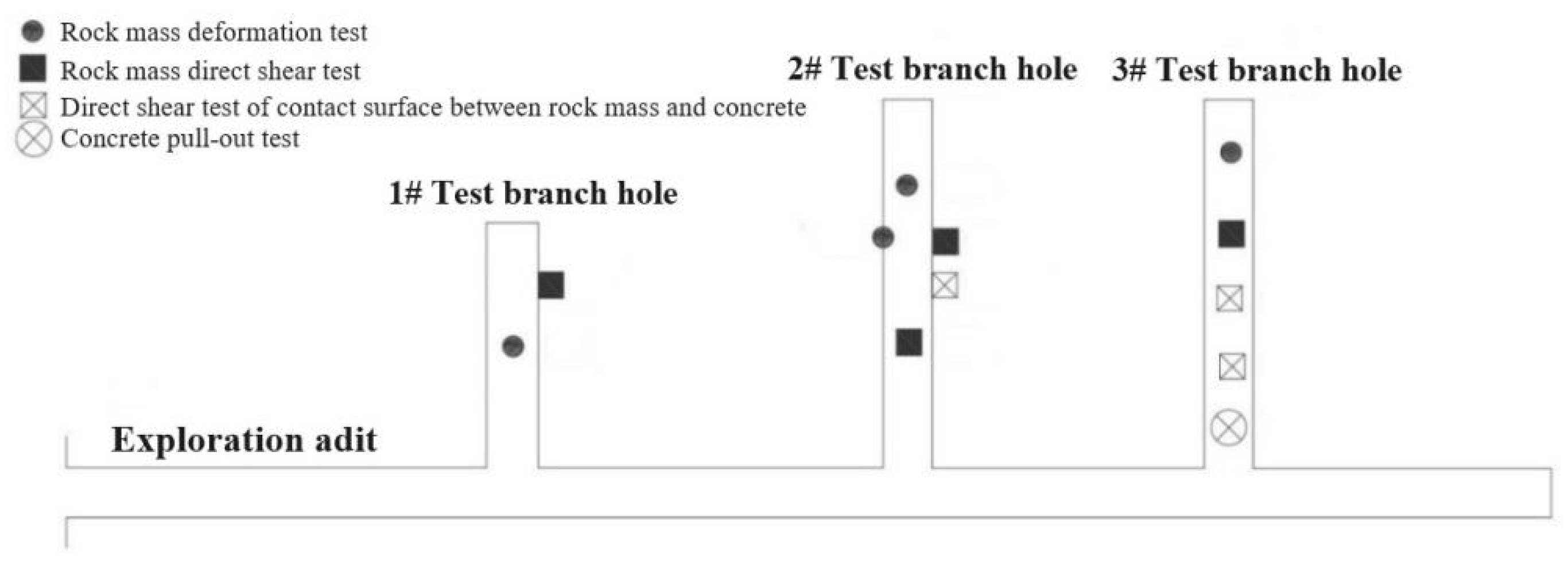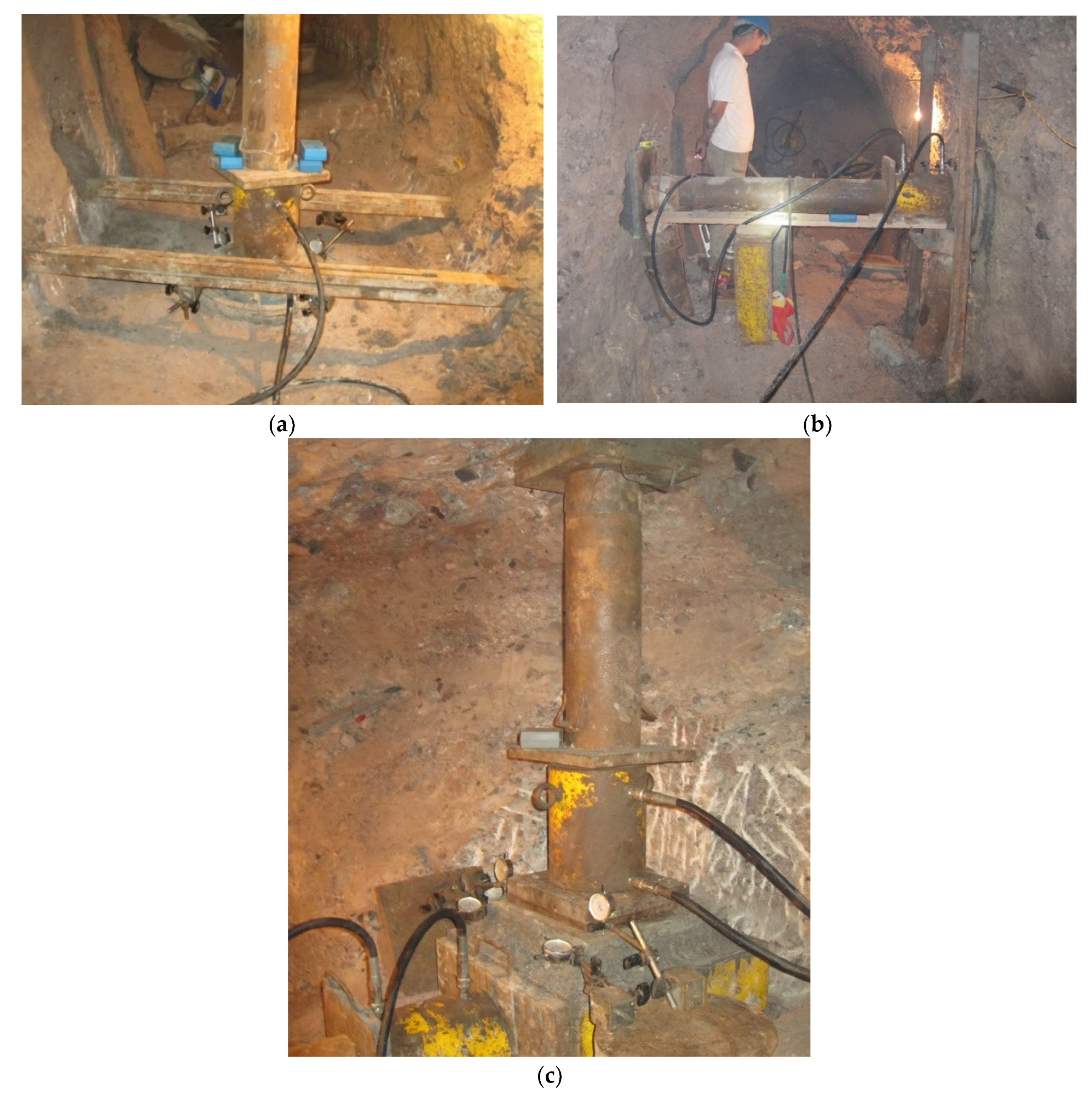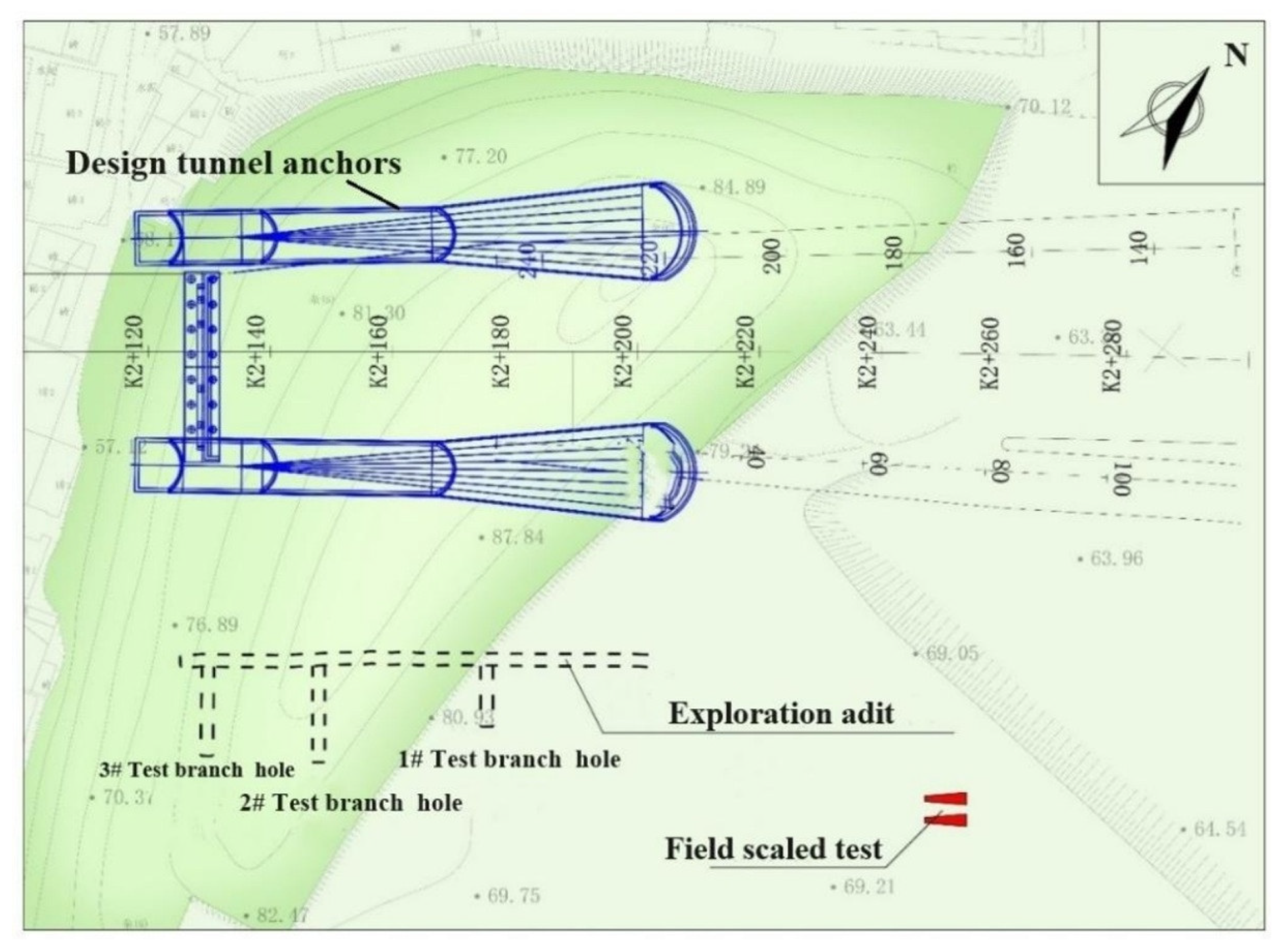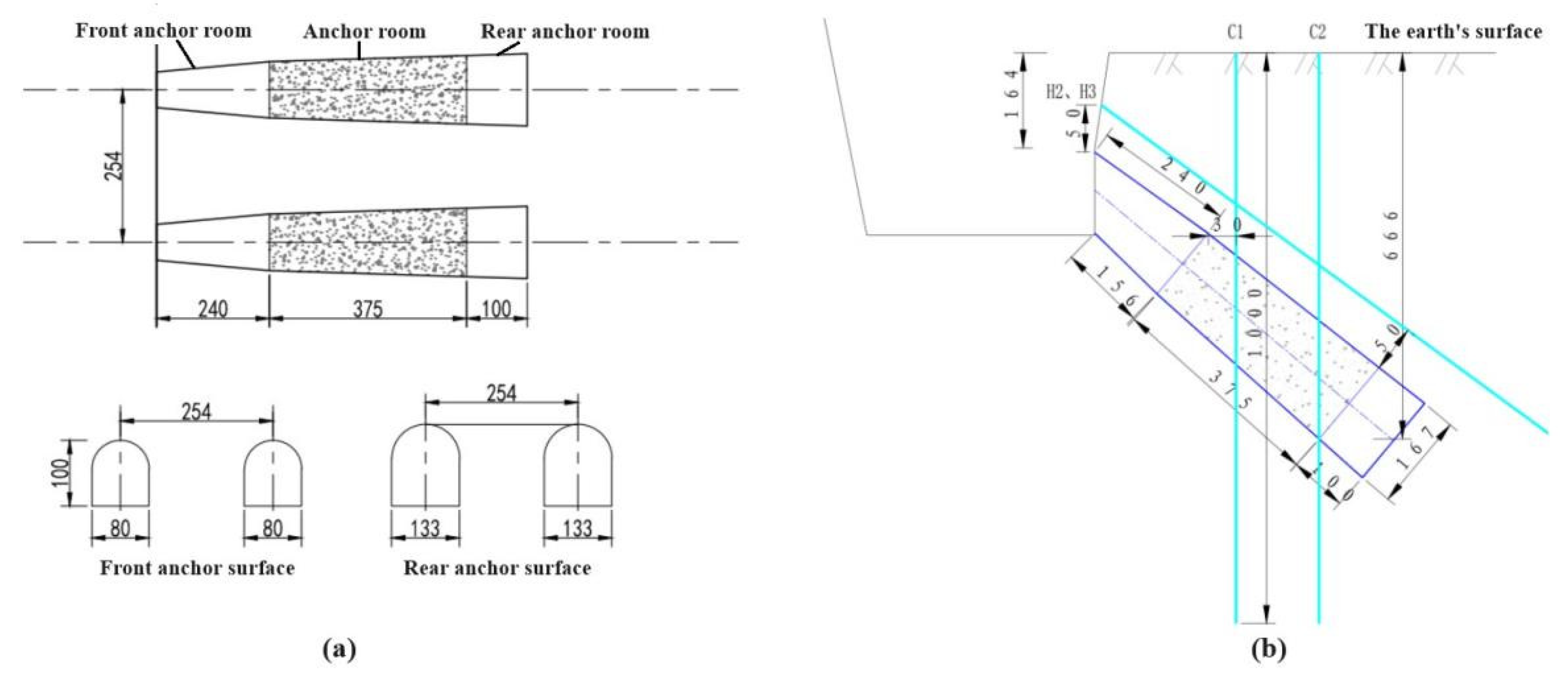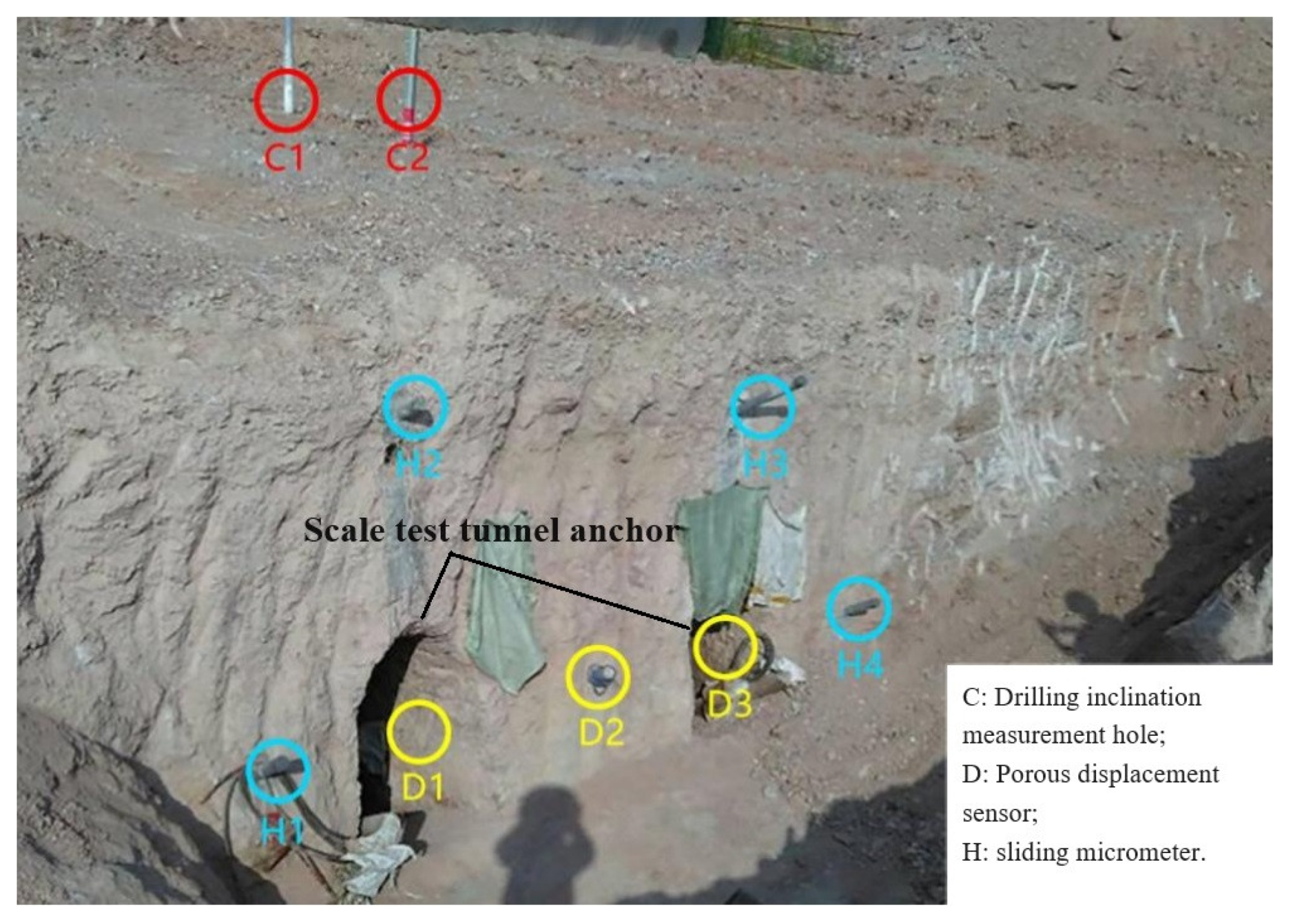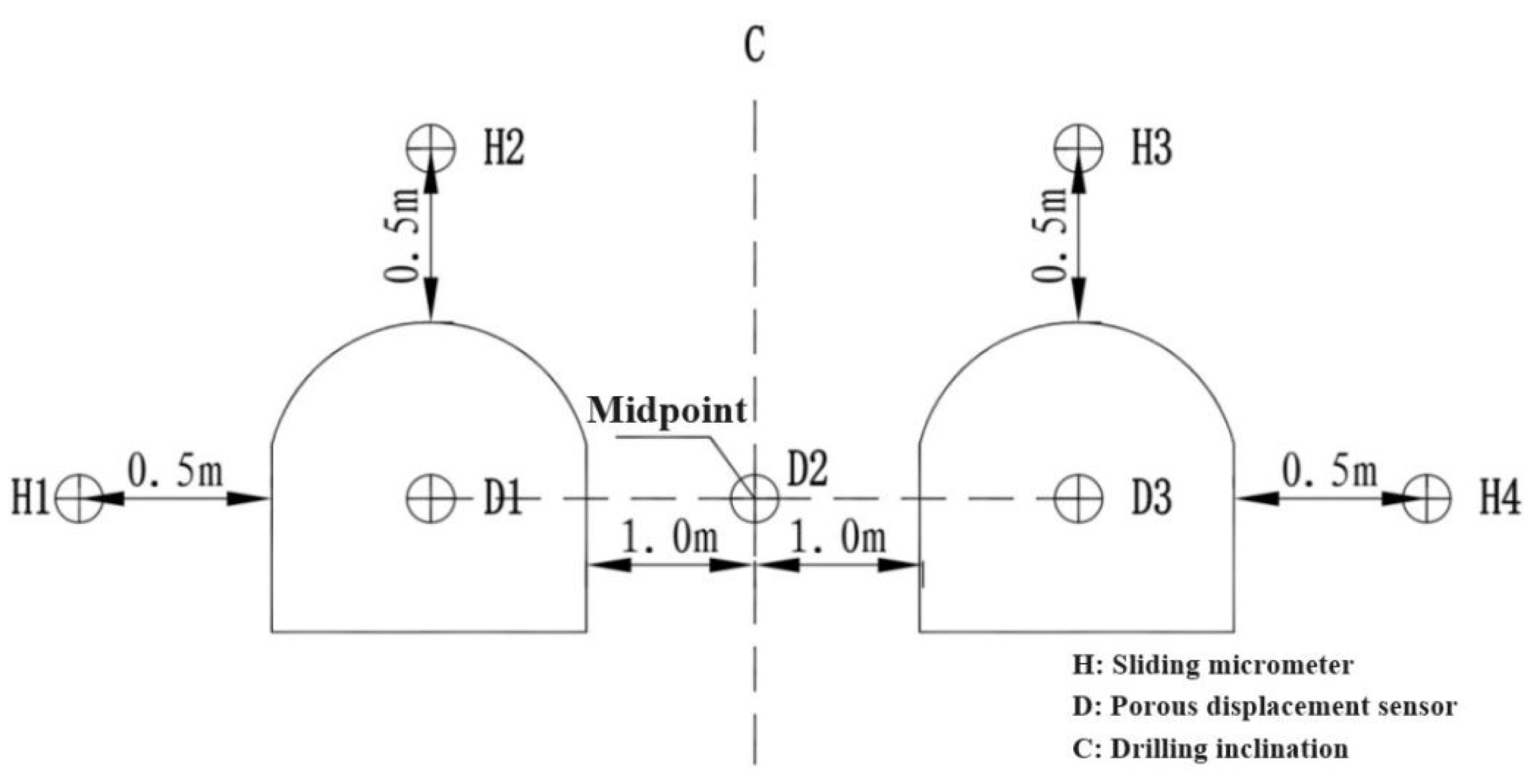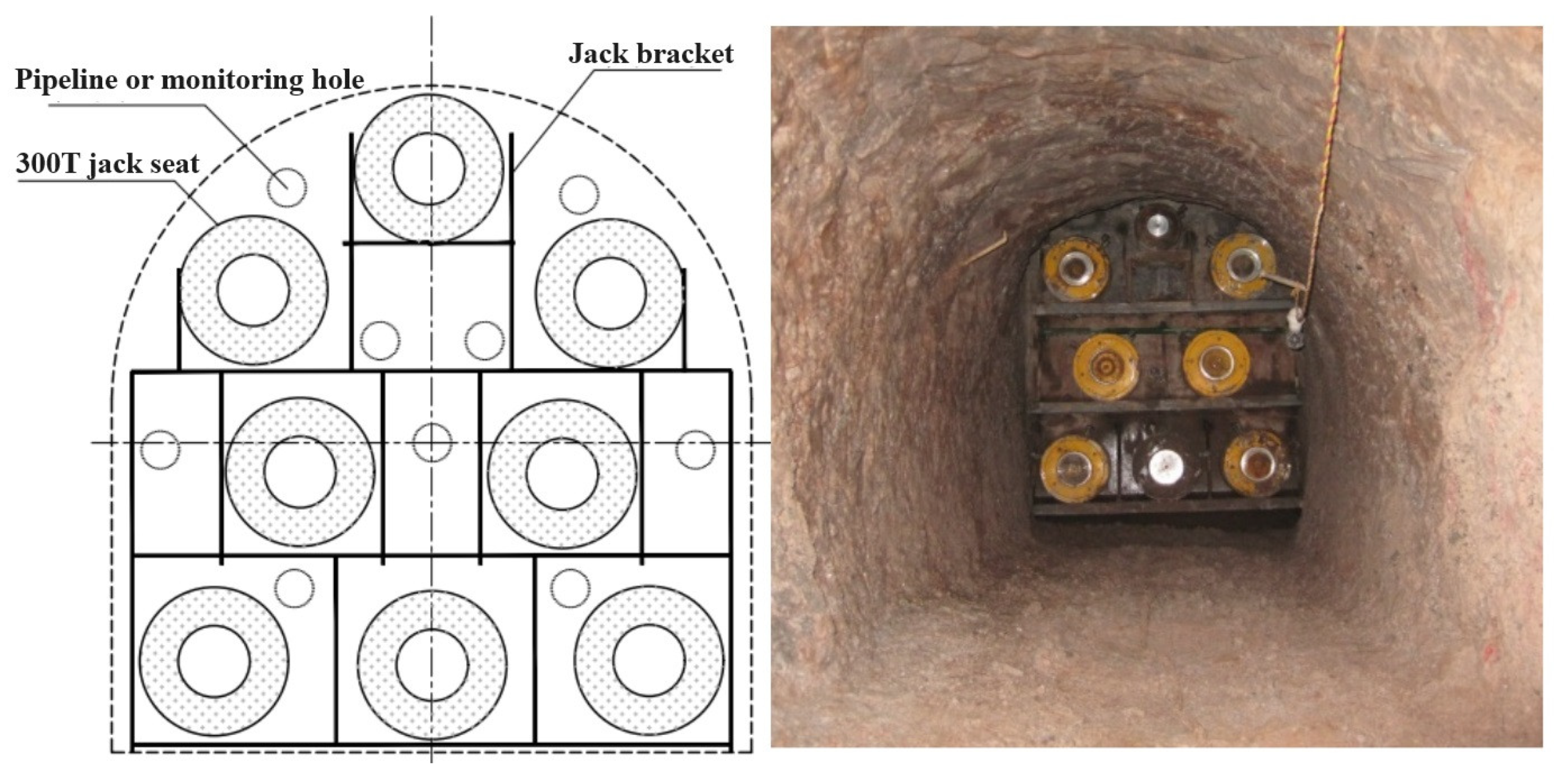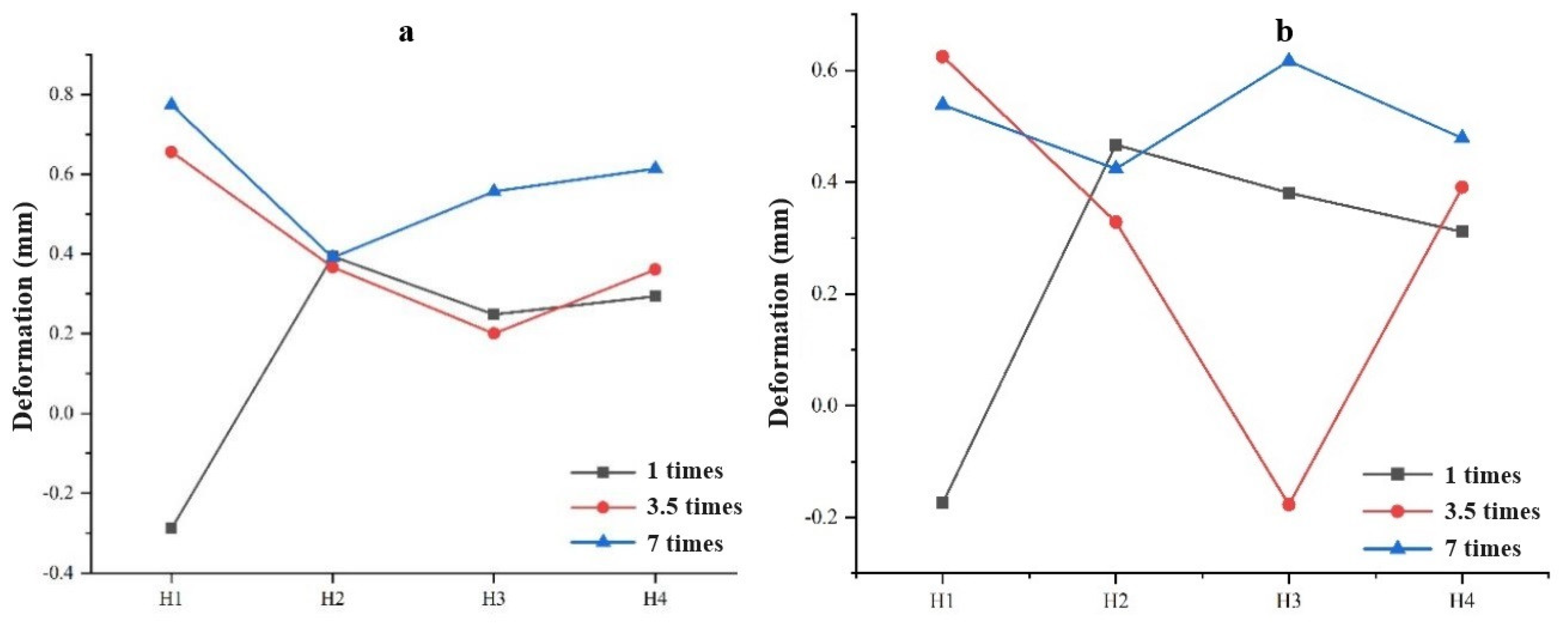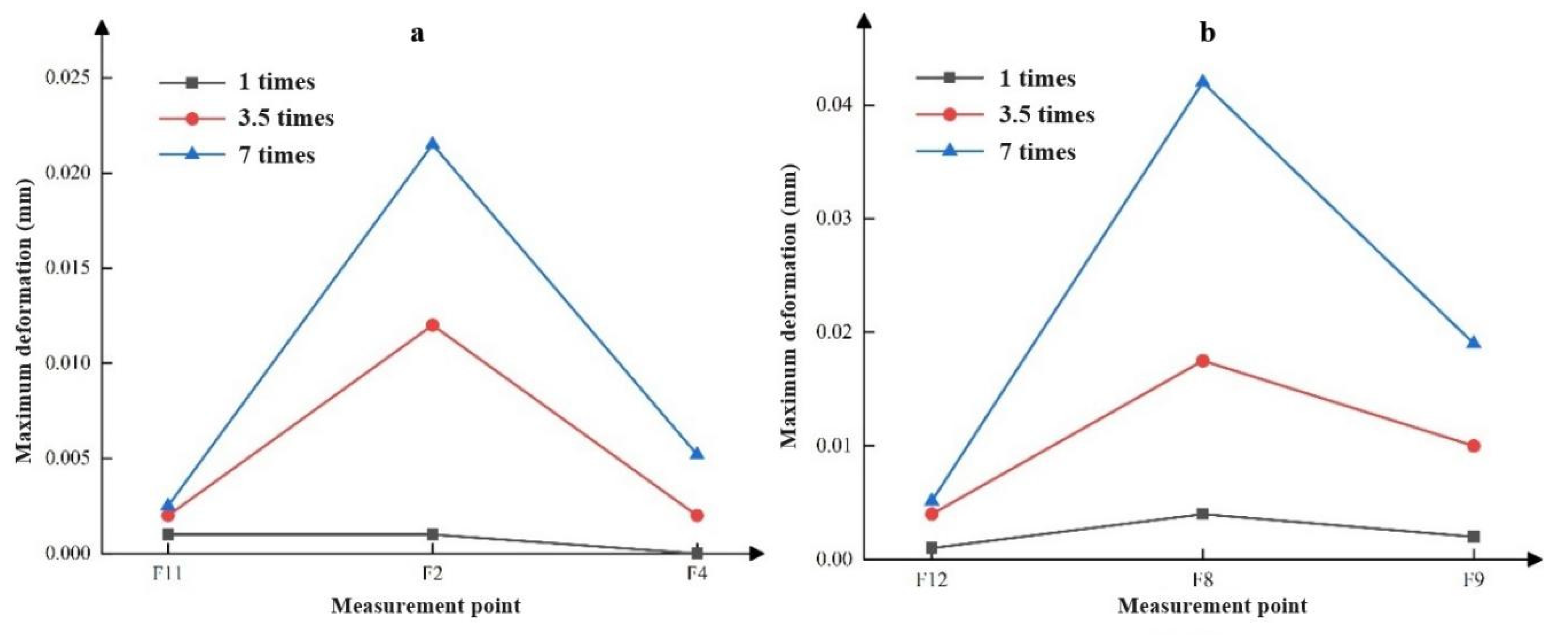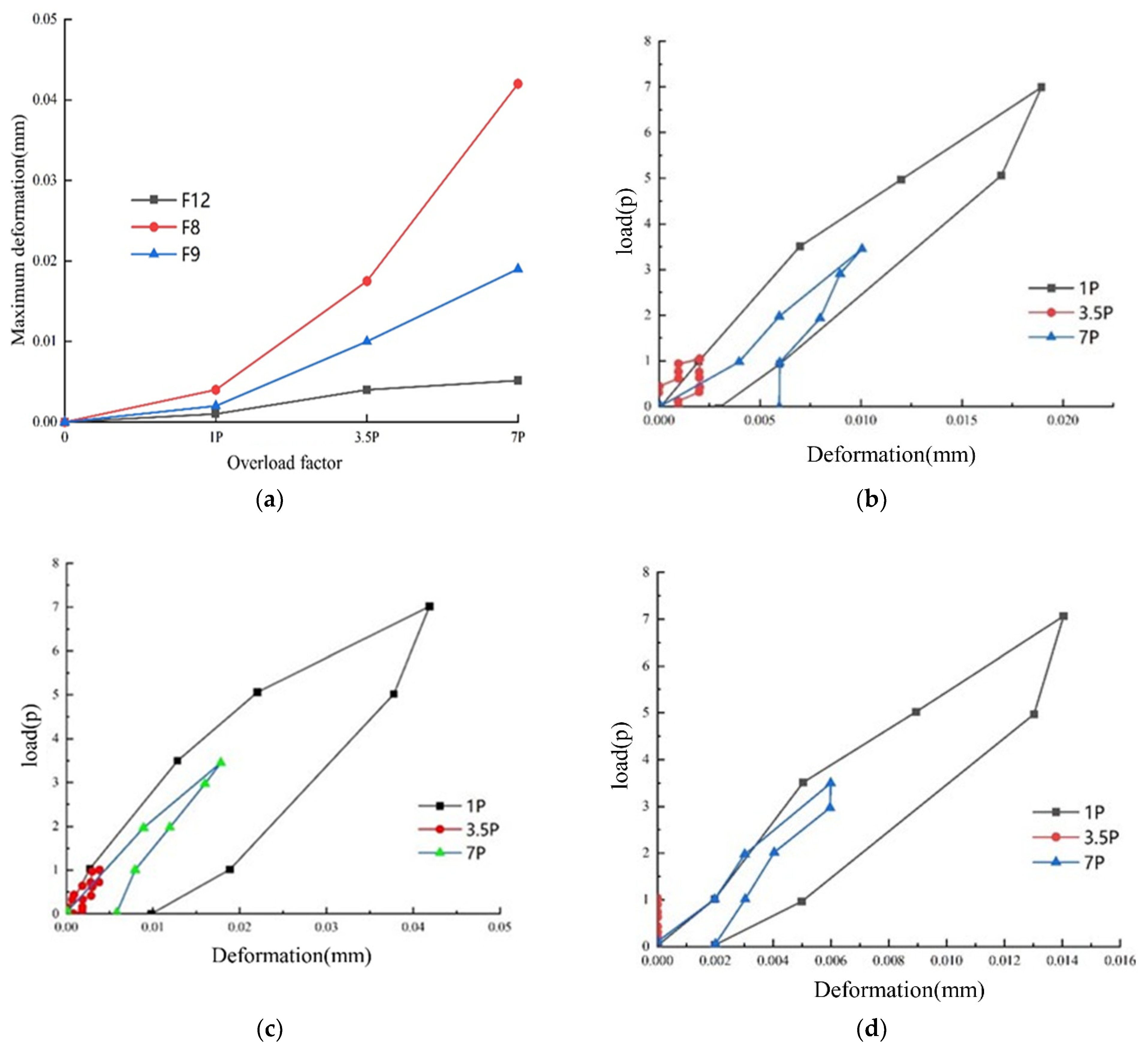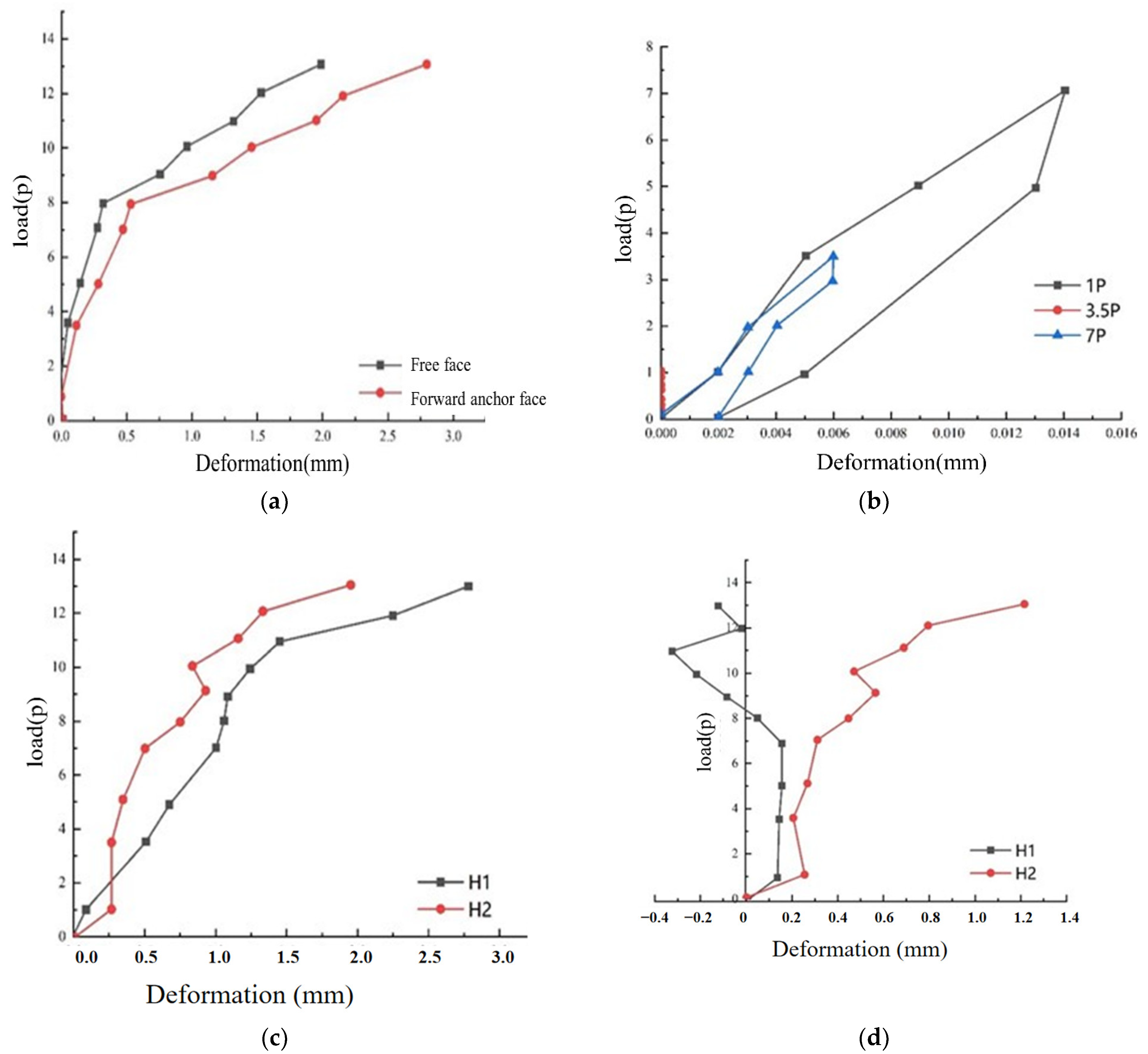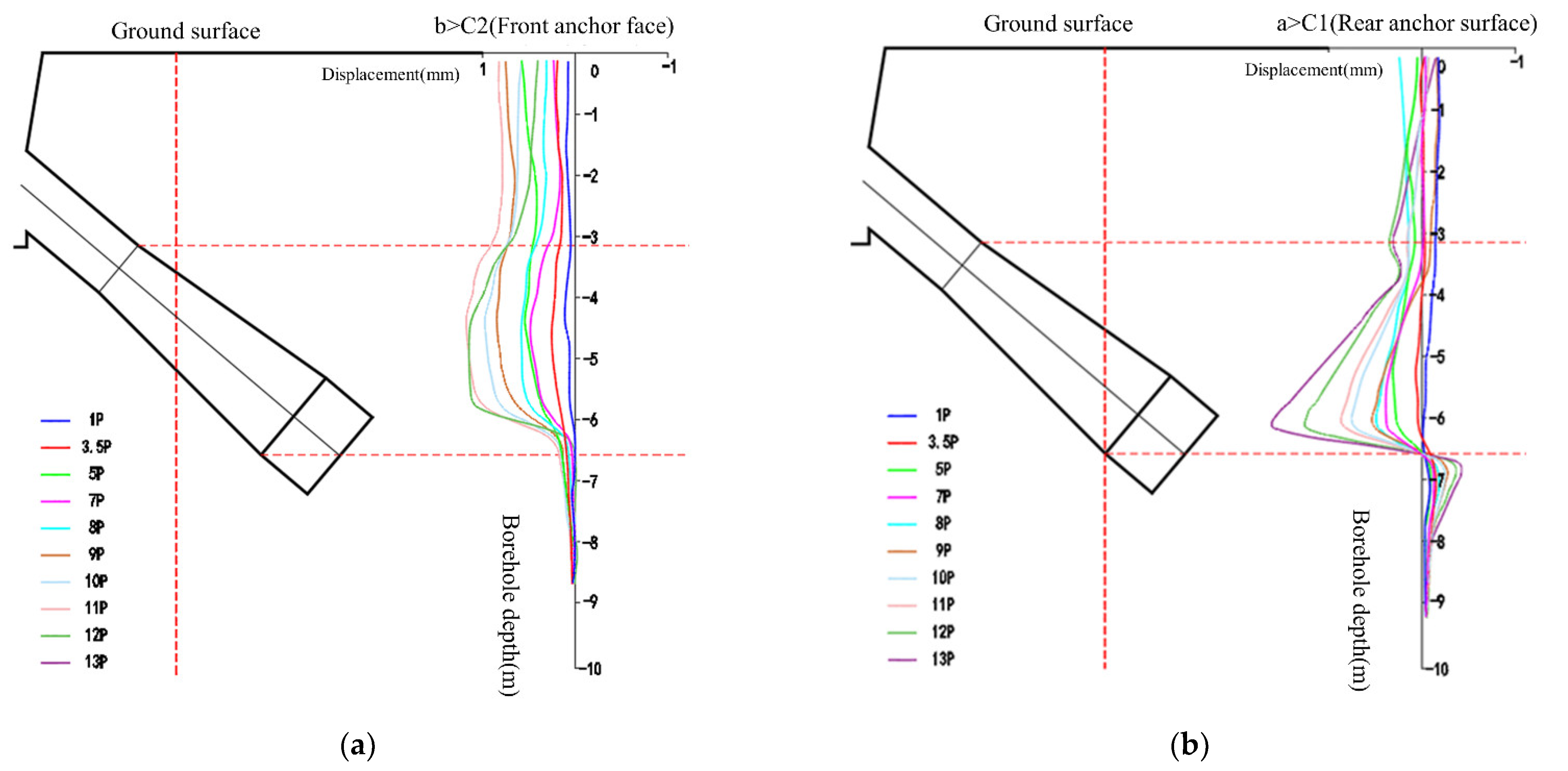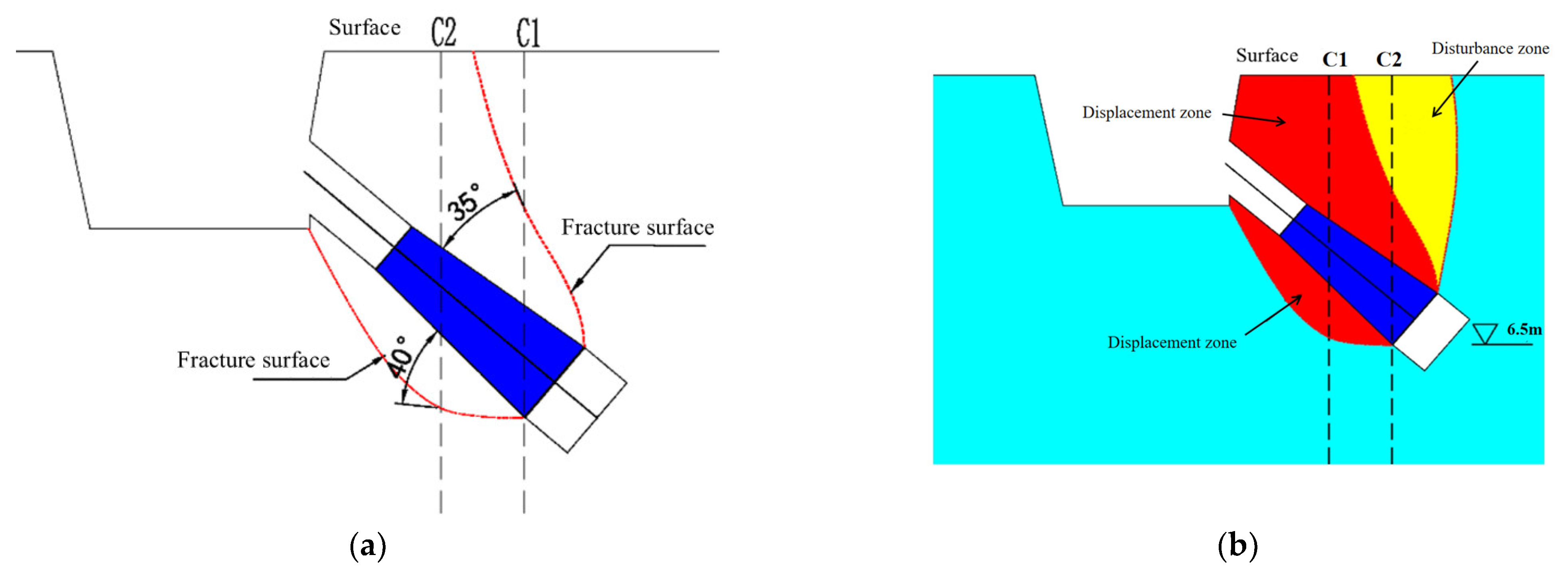1. Introduction
A suspension bridge is a type of large-span bridge that has significant advantages in terms of material performance and the height to span ratio of stiffening beams [
1]. At the same time, it has minimal environmental disturbance and can reduce the construction of large-scale foundation projects. It is currently one of the main forms of large-span bridges, with a unique structure and beautiful appearance. The anchoring methods of suspension bridges can be divided into self-anchoring and ground-anchoring. Self-anchored suspension bridges anchor the main cable on both sides of the stiffening beam, resulting in significant axial pressure on the bridge, which is not suitable for large-span bridges [
2]. Ground-anchored suspension bridges transmit the main cable force to the ground through anchorages, which are supported by anchorages or surrounding rocks. There is almost no axial force inside the beam, which will not cause instability of the stiffening beam. Therefore, ground-anchored suspension bridges can achieve larger spans and are mostly used for large-span bridges. Ground-anchored anchorages are mainly divided into gravity type and tunnel type according to their mechanism of action. Tunnel anchoring is achieved by setting up inverted wedge-shaped anchorages with wide bottom and narrow top, utilizing the surrounding rock within a certain range of the plug to jointly exert bearing capacity. Compared with gravity type anchorages, tunnel anchorages have smaller engineering quantities, flexible arrangements, and are more economical. Tunnel anchorage demonstrates superior performance over traditional gravity/rock anchorage systems in terms of mechanical efficiency, geological adaptability, and construction economy, particularly for suspension bridge projects in deep overburden and hard rock strata. Future research should focus on its long-term performance under extreme loads (e.g., seismic events and vessel collisions) and the development of intelligent construction technologies to expand its application scope. Based on the many advantages of tunnel anchoring, there have been many successful application cases in bridge engineering, but there are still shortcomings in research on bearing mechanism, failure mode, and anchoring potential excavation, which restricts its further promotion and application in bridge engineering construction [
3,
4,
5].
The tunnel anchor, as the main load-bearing part of the suspension bridge’s main cable, effectively improves the overall stability of the suspension bridge’s main tower and bridge due to its load-bearing characteristics [
6]. Therefore, fully considering the bearing capacity and bearing method of tunnel anchors in special geological formations, clarifying the stability, deformation mechanism, and failure mode of tunnel anchor structures and surrounding rocks under load, can effectively clarify the practical application value and promotion significance of tunnel anchors [
7].
The concept of tunnel anchor design was first proposed 1932 and the construction example was the Washington Bridge built with basalt rock as the surrounding rock, and the second suspension bridge using tunnel anchor was built in the San Francisco Bay Area four years later [
8,
9,
10]. Subsequently, the United Kingdom, as the second country to apply tunnel anchor technology to suspension bridges, built the Forth Road Bridge with coarse basalt as the anchor rock in 1964 [
11]. Japan was the first country in Asia to adopt tunnel anchors and built Shimotsui Seto Bridge in diorite and granite surrounding rock mass [
12].
At present, tunnel anchors of suspension bridges can be divided into self-anchored and ground-anchored according to the main cable anchoring forms. Since the anchoring structure of ground anchored suspension bridges and the surrounding rock mass bear the main bridge load, there are more application cases of ground anchored suspension bridges than self-anchored suspension bridges, which improves the crossing ability of suspension bridges on the basis of ensuring the deformation of bridges [
13]. Among the bridges built and put into use at different times, the proportion of tunnel anchor suspension bridges is gradually increasing, but the application of tunnel anchors is affected by factors such as topography, formation lithology, and surrounding rock properties, etc. The early design is relatively conservative, and the application is mostly concentrated on short-span bridges. With the development of tunnel anchor technology, tunnel anchors are gradually applied to long-span suspension bridges.
At present, the construction and application of suspension bridges using tunnel anchors are gradually increasing, and the anchoring strata continue to expand to the soft rock mass with poor rock quality and low mechanical properties, shallow surface rock mass, and areas with complex geological conditions. However, the bearing mode of the tunnel anchor structure and the creep deformation of the surrounding rock mass bearing the uplift load affect the stability of the joint bearing system formed by “tunnel anchor and surrounding rock” [
14,
15]. Therefore, with the increasing application range of tunnel anchors and the trend of complex and diversified anchoring strata, it is of great significance to understand the load-bearing mode of tunnel anchors, the stress and deformation trend of anchoring structure and surrounding rock, and the failure mode and stability of the “tunnel anchor-surrounding rock” co-bearing system [
16,
17].
Tunnel anchor is a key component for the main cable tension transfers to rock mass, and the stability of rock mass in the anchoring area is also a key factor affecting the use of tunnel anchor. The mechanical properties of rock mass in the anchoring area and the bearing state of the anchoring structure jointly affect the safety performance of the suspension bridge and the overall stability of the bridge structure [
18].
Although the parameters of the surrounding rock mass determined by the laboratory model test can reflect the mechanical properties of the anchorage rock mass in the engineering area, the synergistic effect between the “tunnel anchor and surrounding rock” is difficult to be fully revealed due to the length contraction effect.
Therefore, before the actual construction of the tunnel anchor suspension bridge, in order to fully guarantee the optimal design and safe construction of the tunnel anchor, the influence of geological conditions and rock mass characteristics similar to the actual anchoring area on the tunnel anchor system can be determined through in situ model experiments, and the structural and mechanical properties of the rock mass can be further obtained.
Currently, some scholars have investigated tunnel anchor system performance through in situ scaled model tests. However, bridge construction applications based on such test results remain limited in China, particularly regarding tunnel anchors in deep overburden conglomerate strata—an area that still lacks systematic in situ scale research.
Some scholars have analyzed the deformation characteristics and failure modes of tunnel anchor-surrounding rock systems by in situ scaling model tests. Wu et al. revealed the mechanical rock mass characteristics of tunnel anchors under different load conditions through large-scale field model tests and evaluated the potential load-bearing performance of tunnel anchors in the proposed super-large railway suspension bridge based on practical application cases [
19]. Based on field model tests, Han et al. analyzed the load-bearing performance of tunnel anchors in soft rock with weak interlayers, and divided the deformation stages of the surrounding rock, and determined that the final failure mode of tunnel anchors under special geological conditions was similar to that of inverted wedges [
3,
20].
At the same time, relevant scholars analyzed and determined the bearing capacity of tunnel anchors under different rock mass conditions based on the field model test monitoring data, which provided references for the actual construction of suspension bridges. Shen et al. conducted a design load test, an overload test, a failure test, and a rheological test on the field scale model of 1:12, and the results showed that when the test load exceeded the overload stability coefficient, there would be an obvious inflection point; when the test load was less than the overload stability coefficient, the anchorage deformation and rheological characteristics were not obvious [
21].
Based on the characteristics of rock mass at the test site and the performance of the test instrument, the relevant scholars improved the in situ scaling model test. Since the field scale model test is easily affected by the field loading conditions, and it is generally difficult to reach the surrounding rock failure conditions, it is difficult to fully grasp the failure form and uplift process of the surrounding rock in the anchoring area and determine the ultimate bearing capacity of the tunnel anchor [
22]. Therefore, by simulating the failure conditions of surrounding rock through a similar indoor model test, it can further deepen the failure form of surrounding rock and the working mechanism of the “tunnel anchor-surrounding rock” co-bearing system.
At present, relevant scholars have studied the relevant mechanism and optimal design of tunnel anchors and surrounding rock based on the tunnel anchor indoor model test. Some scholars have conducted relevant studies on the stress and deformation of the tunnel anchor body and surrounding rock, the stress mechanism and bearing capacity of anchor structure, and the deformation mechanism of surrounding rock by changing the variables such as anchor depth and surrounding rock conditions in laboratory model tests [
23]. The collaborative analysis of numerical simulation results and tunnel anchor indoor model test data also provide a theoretical basis and reference for the analysis of failure deformation modes and bearing characteristics of tunnel anchors and the surrounding rock. Lim et al. (2021) and Seo et al. (2021) conducted tunnel anchor pullout tests based on indoor model tests [
24,
25,
26,
27]. Based on the test data and tunnel anchor failure phenomenon, the bearing capacity and failure mode of tunnel anchors were further analyzed on the basis of clarifying the influencing factors of tunnel anchor failure.
The above field and laboratory model experiments have played a key guiding role in the subsequent analysis of tunnel anchor-bearing capacity and tunnel anchor system stability, but both of them will be affected by in situ test site conditions, similar test materials, and safety assurance. Therefore, the relevant test results are insufficient to fully understand the load-bearing characteristics of tunnel anchors under different engineering geological conditions and the failure modes affected by the mechanics and structural characteristics of surrounding rock mass. Therefore, it is very important to study the load-bearing mechanism of tunnel anchors and the deformation of surrounding rock mass.
The main disadvantage of tunnel anchorage is that the geological conditions of the surrounding rock in the anchoring area are relatively high, which involves the interaction between the anchorage and the surrounding rock and the deformation of rock mass under load, and its bearing mechanism is relatively complex. Wujiagang Yangtze River Bridge is the first tunnel anchorage with conglomerate strata in China. Its geological conditions are complicated, and the overlying rock mass is soft, layered, and poor in uniformity. The research in this paper not only greatly reduces the project investment and environmental cost of Wujiagang Yangtze River Bridge but also provides a theoretical basis and practical reference for the construction of tunnel anchorage in small mountain complex strata in flat or hilly areas.
4. Field Scale Test
In order to study the feasibility of tunnel anchoring schemes in sandstone formations, field-scaled tunnel anchoring test was designed. Field scale testing allows for large-scale structures of testing equipment and material models, without indoor site limitations, reducing costs, simplifying model production and disassembly, and saving material costs. The efficiency of on-site scaling tests has been improved. Due to the smaller size and lower load requirements of scaled models compared to real components, the testing process can be accelerated, and the testing period can be shortened. The more consistent the rock type selected for the anti-pull test of tunnel anchorages is with the actual rock type, the closer the obtained load strain characteristics, anti-pull capacity, and anti-pull mechanism of tunnel anchorages are to reality. The open site facilitates the entry and exit of large equipment, and larger scale models can be selected to reduce the impact of size effects. And the on-site testing is highly targeted, taking into account the actual site conditions and environment, such as temperature, humidity, lighting, etc., to eliminate external factors. At the same time, the terrain can be fully utilized to make the scaled model more realistic in terms of terrain similarity, and the load size, loading rate, boundary conditions, and other influences can be accurately controlled on site. The scale test made on site can successfully describe the test results that are consistent with the actual situation. This article conducted on-site scaled model experiments, considering the construction conditions, site size limitations, and budget. The scale used for this model experiment was 1:12.
4.1. Model Construction
According to the principle of similarity, under the same material conditions, the model size of the on-site scaled model test is reduced by 1:12. When physical force is not considered, the ratio of strength and elastic modulus between the prototype and the solid is 1:1, and the load ratio is 1:144.
The scaled model test was conducted by comparing the terrain, physical and mechanical properties of the rock mass, and other conditions. It was selected at a relatively open and spacious platform in the northern part of the hill where the tunnel anchor is located. The test plan was arranged according to the actual double anchoring mode of the tunnel anchor. The test location is shown in
Figure 4.
In addition to scaling the geometric dimensions proportionally, consideration was also given to terrain similarity in this experiment. The terrain consistent with the solid was obtained through manual excavation, as shown in
Figure 5 and
Figure 6.
Through on-site investigation, it was found that the first section (K2l1) of the Luojingtan Formation, which was selected for the physical anchor, has a relatively deep burial depth and cannot be obtained on site. Therefore, the upper rock mass of the third section (K2l2) was ultimately chosen as the experimental stratum. The selected rock mass is consistent with the actual lithology of the stratum and also contains typical sandstone bands. The integrity of the model anchor surrounding rock is consistent with that of the actual bridge anchor surrounding the rock.
According to the results of three sets of samples in the conglomerate (K2l2) where the model anchor is located, the average saturated uniaxial compressive strength is 15.6 MPa, which is basically consistent with the strength of the loaded surrounding rock of the actual bridge tunnel anchor. Through comparative analysis, the geological conditions of the surrounding rock selected for the model experiment are similar to those of the surrounding rock of the actual bridge anchorage, and the quality of the surrounding rock of the actual bridge anchorage is slightly better than that of the model anchorage.
The anchorage should be made at a ratio of 1:12, and the corresponding model anchor hole size should meet similar requirements. Based on the future anchor surface, the anchor depth is 6.7 m, the axis spacing is 2.5 m, and the anchor length is 3.75 m. The angle between the axis of the model anchor and the horizontal is 40°, which is the same as the burial angle of the actual bridge anchor, as shown in
Figure 7.
The anchor body is made of reinforced concrete, with five longitudinal steel arches and horizontally arranged stirrups, all of which are made of 10 mm threaded steel and poured with C40 concrete.
4.2. Experimental Monitoring Plan
Nine monitoring holes are set up in the anchorage and surrounding rock during the experiment, and the detailed locations of each monitoring hole are shown in
Figure 8 and
Figure 9. The inclinometer hole employs a high-precision digital inclinometer (Shaanxi Right M&C Technology Co., Ltd., Xi’an, China) with an accuracy of ±0.02 mm/m, the sliding micrometer utilizes an SMP-100 model sliding micrometer with ±0.003 mm precision, and the multi-point borehole extensometers adopt vibrating wire-type displacement sensors (Durham Geo Slope Indicator, Seattle, WA, USA) with ±0.1% FS accuracy.
C1 and C2 inclinometer holes are vertically arranged in the surrounding rock between the double anchors, with C1 located on the front anchor surface and C2 located on the rear anchor surface. Multiple displacement monitoring holes, numbered D1, D2, and D3, are arranged parallel to the axis direction of the anchor and double anchor centerlines. On the upper surrounding rock of the double anchor and on both sides of the double anchor, parallel to the anchor axis direction, sliding micrometer monitoring holes are arranged with a spacing of 0.5 m, and the monitoring hole numbers are H1, H2, H3, and H4, respectively.
4.3. Experimental Loading and Process
The scaling test adopts the backward push method, using the rear rock mass to provide reactive force to simulate the pulling force of the anchorage. In this test, eight jacks are installed, and 50 cm and 30 cm reinforced concrete reaction plates are poured at the front and rear ends of the jacks, respectively, to make the anchorage more evenly stressed. Reinforced concrete reaction plates are reinforced with threaded steel bars. Each anchor is equipped with eight jacks, which can load up to a maximum of 2000 tons, equivalent to 13 times the design load. Shown as
Figure 10.
The load test adopts a cyclic loading method for graded loading and unloading. Single design load is loaded in 5 levels and then unloaded to zero. When the test begins to load, recording begins immediately, with an interval of 10 min. If the continuous recording difference is less than 0.002 mm, it can be considered that the deformation of this level has stabilized, and the next level of load can be carried out sequentially. The recording method and requirements for unloading are the same as those for loading.
Based on relevant scholarly research and industry standards, this test conducted overload tests at 3.5 times and 7 times the design load, with loads ranging from 5 to 7 levels depending on the situation [
3,
28].
The load rheological test adopts step-by-step large cycle loading, and the load remains unchanged after being added to the design load. The first half hour is recorded every 5 min, followed by 1 h, 2 h, 4 h, 8 h, 16 h, and 24 h, and then recorded twice a day thereafter. When the difference between records within 24 h is less than 0.002 m, it is considered rheological stability.
The destructive test is conducted after the rheological test is completed, and the designed load is applied in stages until failure or reaching the maximum load level of the jack.
6. Conclusions
This study conducted on-site 1:12 scale model tests on complex strata (conglomerate tunnel anchorages), taking into account the similarity of terrain and lithology. The test contents included design load tests, overload tests, and failure tests. The main research conclusions obtained are as follows.
(1) The deformation of the sliding micrometer under the design load was analyzed, and it was found that the deformation at the free face was the largest, followed by the deformation at the front anchor face, and the deformation at the rear anchor face was the smallest.
(2) The deformation of dislocation meter under the design load was analyzed, and it was found that relative deformation between the anchor and the surrounding rock is largest in the middle of the anchor body, followed by the rear anchor surface, and the displacement deformation of the front anchor surface is the smallest.
(3) The deformation of the strain gauge inside the anchorage was analyzed, and it was found that the deformation of the rear anchor surface is the largest, followed by the middle part, and the deformation of the front anchor surface is the smallest, with a significant difference in deformation between the front and rear anchor surfaces, revealing the phenomenon of stress concentration on the anchor surface after anchoring.
(4) The deformation of each monitoring point under 3.5 P and 7 P overload was analyzed, and the same pattern as under 1 P load was found, that is, the maximum displacement between the anchor plug and the surrounding rock occurred in the middle of the anchor body, and the maximum strain occurred on the anchor surface after anchoring.
(5) The deformation trend of the anchor and surrounding rock under stepwise loading was studied through destructive tests, and it was found that the deformation of the surrounding rock and anchor increased nonlinearly between 8 P and 10 P. The overload coefficient of the anchor was proposed to be 8 P.
These findings establish a comprehensive technical framework for improving tunnel anchorage design practices in conglomerate strata, providing three key advancements: (1) a basis for revising safety factors in current design codes to account for conglomerate-specific behaviors; (2) scientifically grounded protocols for stage-construction monitoring, with quantified thresholds for displacement and strain control; and (3) optimization methodologies for anchorage systems in heterogeneous rock masses, including targeted reinforcement strategies and advanced grouting techniques. The framework addresses critical gaps between conventional design approaches and the actual mechanical responses observed in conglomerate environments, offering practical solutions for safer and more efficient anchorage system implementation. Based on the results of these studies, later research has focused on numerical simulation analysis, comparing the numerical analysis results with the results of physical model experiments to obtain a more accurate deformation and failure mechanism of the surrounding rock for tunnel anchoring.

